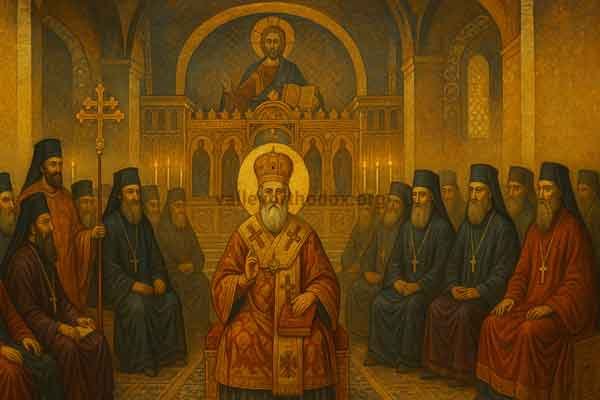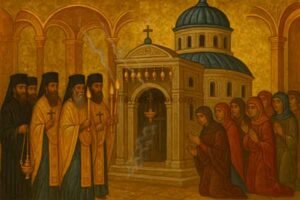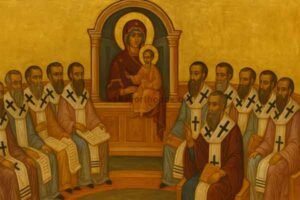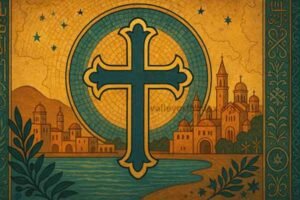From Byzantium to New Rome
Founded in the reshaped capital of the Eastern Roman Empire, the Church of Constantinople rose in prominence with the city itself. Councils recognized the see’s special responsibilities as New Rome, calling it to service among the patriarchates while preserving the synodality that marks Orthodox governance.
Primacy of Honor and Synodality
What “Ecumenical Patriarch” Means
The title expresses a primacy of honor—a ministry of coordination, witness, and service, not unilateral rule. The Ecumenical Patriarch convenes and presides in synod as first among equals, fostering cooperation among the autocephalous Churches.
Councils and Canonical Reference Points
Historic canons—Canon 3 of Constantinople (381) and Canon 28 of Chalcedon (451)—located the see of Constantinople as “second after Old Rome” on account of its status as New Rome. They also outlined concrete responsibilities: oversight within the imperial dioceses of Thrace, Asia, and Pontus, the confirmation/ordination of metropolitans in those regions, and a role in receiving appeals so that local disputes could be resolved within a wider conciliar frame.
Across the centuries, this translated into service to unity: the Ecumenical Patriarchate became a point of reference for letters of communion, adjudication in difficult cases, and the convening or hosting of synods at Constantinople when common teaching or discipline needed articulation. In the modern period, that same service appears in the recognition of autocephaly by tomos, coordination of pan-Orthodox consultations and gatherings, and pastoral care for communities in new contexts (including the diaspora) until stable local structures emerge.
All of this expresses a primacy of honor exercised within synodality—not centralized rule, but a ministry of coordination, witness, and appeal aimed at safeguarding communion among the Orthodox Churches.
Liturgy, Monasticism, and Learning
Worship and the Arts
The Patriarchate celebrates the Byzantine rite, cultivating chant, iconography, and homiletics that shaped Orthodox worship across centuries. The Phanar today remains a center of liturgical life and pastoral outreach.
Monastic and Educational Witness
Monastic communities and theological schools historically nurtured clergy and scholars, forming a tradition of learning in service of prayer. Libraries, archives, and contemporary publications continue this work.
Trials, Continuity, and Global Mission
Across shifting empires and modern challenges, the Ecumenical Patriarchate sustained liturgy and pastoral care. Today it serves diaspora communities through metropolises worldwide, supports mission, and engages in theological dialogue and creation care initiatives—always within the horizon of Orthodox faith and worship.
Governance and Today’s Service
Holy Synod and Eparchies
The Ecumenical Patriarch with the Holy Synod oversees eparchies and metropolises, coordinating pastoral life, clergy formation, and canonical order, especially where multiple cultures and languages meet in the diaspora.
Pan-Orthodox and Inter-Christian Relations
The Patriarchate facilitates common witness with sister Orthodox Churches and maintains dialogues with other Christians, offering a voice of conciliation grounded in the Fathers and the councils.
Heritage: Councils, Churches, and Sacred Art
From Hagia Sophia’s legacy to living parish churches and monasteries, Constantinople’s artistic and liturgical heritage shaped Orthodox identity far beyond the capital. Sacred art and architecture remain a catechesis in beauty.
Timeline & Quick Reference
- 4th–5th centuries: Rise of New Rome; conciliar canons define standing.
- Byzantine era: Liturgical, monastic, and theological development radiates outward.
- Modern period: Trials and renewal; global pastoral ministry through the diaspora.
- Today: Service of unity, synodality, mission, and education across the Orthodox world.
FAQs
What is meant by “primacy of honor”?
A first-place service among bishops—presiding in synod, coordinating, and witnessing to unity—without supremacy over other autocephalous Churches.
Does the Ecumenical Patriarchate govern all Orthodox Christians?
No. Each autocephalous Church governs itself. The Ecumenical Patriarch’s role is coordinating and convening, not ruling others.
Why is Constantinople called “New Rome”?
Ancient canons recognized the city’s imperial status, assigning corresponding responsibilities within the Church’s conciliar life.



